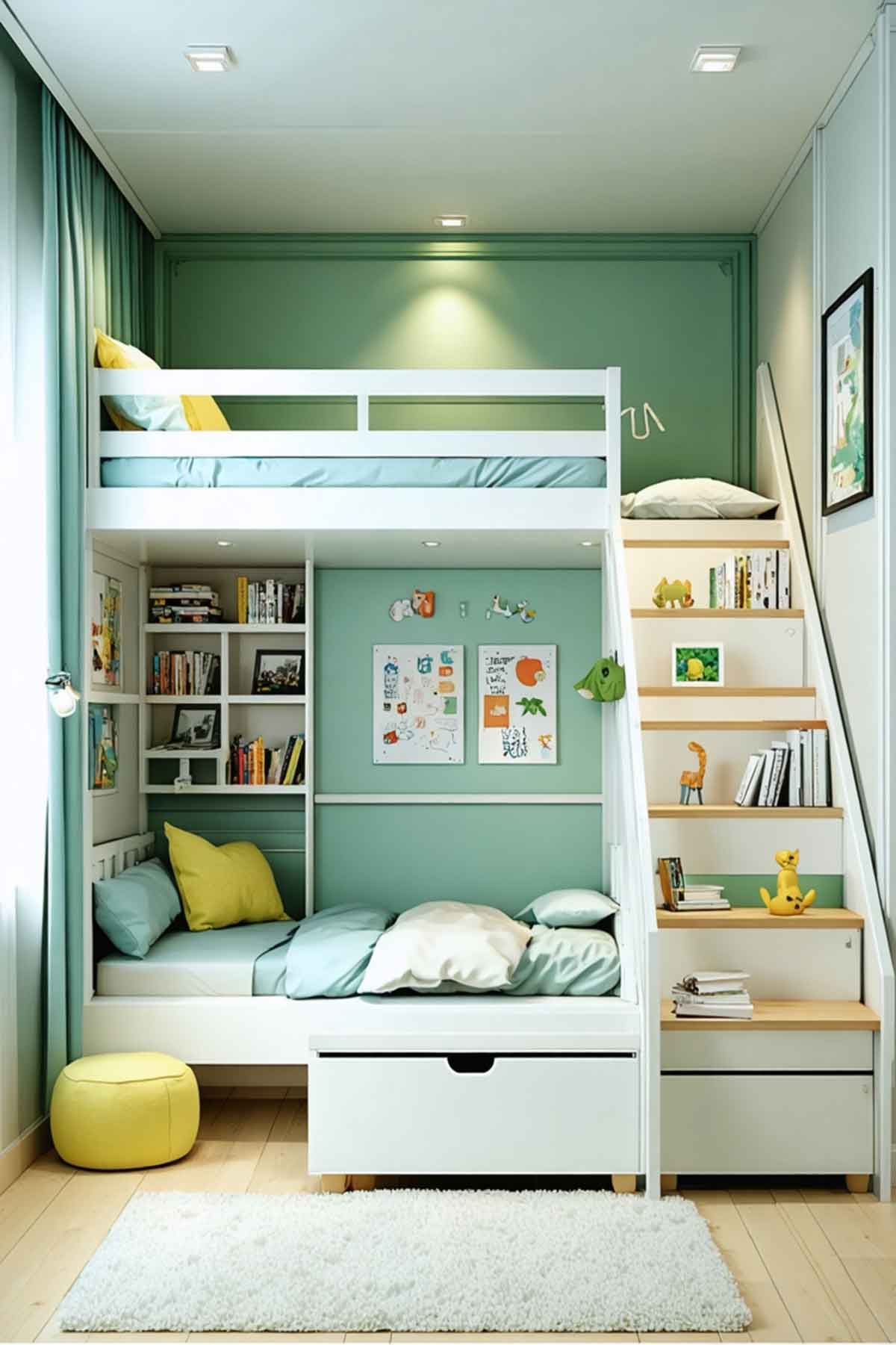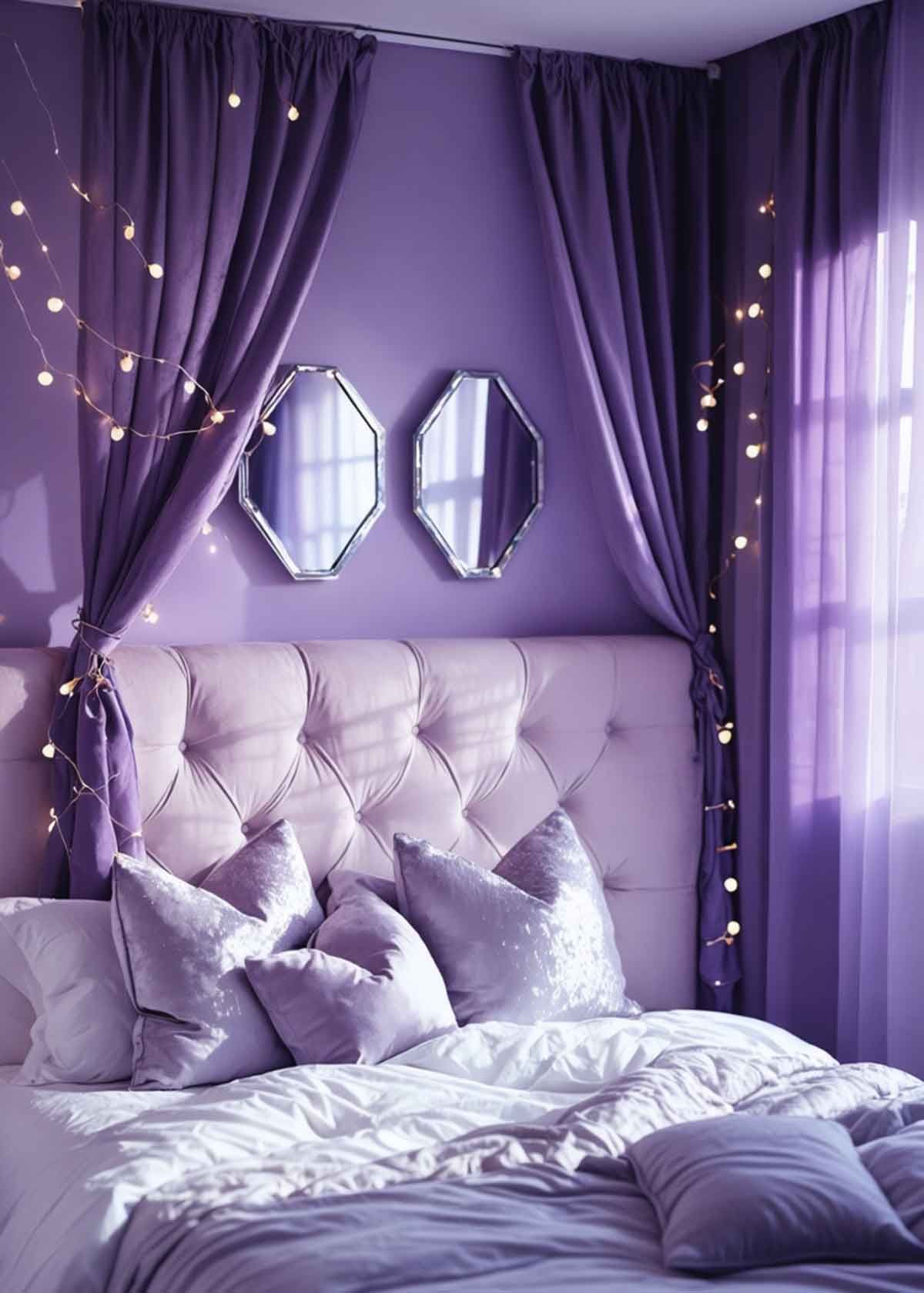The Secrets to Designing a Relaxing Sleep Space
Sleep Better With A Well Designed Bedroom
Turning your bedroom into a peaceful place can really help you sleep better. Experts say good sleep is key for your health. To make a relaxing sleep area, get a quality bed frame, pick calming colours, and add soft furnishings.
Designing your sleep space right can make it a place to relax and recharge. Choosing the right colors and arranging the room well are important. These tips can help you sleep better with good bedroom design. Learn how to design a relaxing sleep area that fits your needs.
Understanding the Importance of Sleep Environment
Creating a relaxing sleep environment is key for your health and happiness. Good sleep boosts your energy, brain function, and physical health. Stress and outside factors can harm your sleep, so make your bedroom a peaceful place.
How Sleep Affects Health
Quality sleep is vital for your body and mind to heal. Research shows poor sleep can increase obesity, heart disease, and depression risks. A good sleep routine and a calm bedroom can greatly improve your health.
The Role of a Calm Atmosphere
A calm bedroom helps reduce stress and improves sleep. Things like temperature, lighting, and noise affect your sleep quality. A cozy, quiet bedroom is perfect for relaxing sleep and feeling refreshed.
"A good night's sleep is essential for physical and mental health. Creating a comfortable, calming sleep environment is the first step towards designing your bedroom for sleep."
Your sleep space is vital for your health and happiness. By focusing on a relaxing sleep area, you can make your bedroom better for quality sleep.
Choosing the Right Colour Palette
The colour palette you pick is key to a relaxing sleep area. Opt for soft, muted, or neutral tones. Cool blues and gentle greens work well for walls, curtains, and bedding. Earthy tones like beige and taupe add warmth and grounding.
Calming Colours That Promote Relaxation
Lavender is great for bedrooms because it helps with sleep and relaxation. Grey is also popular for its versatility. It matches many shades, room sizes, and light levels.
Green, like mint, olive, and sage, brings tranquillity. Blue, in lighter shades, is calming and perfect for small spaces.
The Psychology of Colour in Sleep Spaces
Blush pink creates elegant, romantic retreats. Lemon yellow, in a gentle tone, makes bedrooms tranquil and soothing. Neutral colours like beige, grey, and off-white calm the atmosphere. Cool colours like blues, greens, and purples lower heart rate and soothe breathing, improving sleep.
Choosing a harmonious color palette for bedding, pillows, and walls enhances relaxation. Adding accessories like coloured bean bag beds can also improve the look without repainting.
| Color | Benefits for Sleep Spaces |
|---|---|
| Lavender | Improved sleep and relaxation |
| Grey | Versatile and matches various shades, room sizes, and light levels |
| Green | Promotes tranquility and peace |
| Blue | Calming and fits well in smaller spaces |
| Blush Pink | Elegant and romantic |
| Lemon Yellow | Tranquil and soothing |
| Neutral Colors (Beige, Grey, Off-White) | Promote better sleep by creating a calming atmosphere |
| Cool Colors (Blues, Greens, Purples) | Decrease heart rate and soothe respiration, leading to better sleep quality |

Selecting Comfortable Bedding
Choosing the right bedding is key for a good night's sleep. The materials and how they're made can greatly affect your sleep. Look for breathable, natural fibers to sleep better with good bedroom design.
Materials Matter: Cotton vs. Linen
Cotton and linen are top picks for bedding because they're light and breathable. Percale weave cotton is known for its crisp, cool feel. Bamboo-derived textiles are also great, needing less water to grow and having antibacterial properties.
Linen is durable and keeps a steady temperature, getting softer with each wash. It's also more sustainable than cotton, needing less water and pesticides.
The Impact of Thread Count on Comfort
Thread count is important when picking bedding. Look for a count between 200 and 400 for a luxurious feel. But remember, higher numbers don't always mean better quality. Focus on the fibres and weave instead.
Using a lavender-scented detergent can add a calming touch to your bedding. Adding soft throws and plush pillows can also make your sleep space cozy and comfy.
A good night's sleep is essential for our overall health and well-being. Investing in the right bedding can make a significant difference in the quality of your sleep.
Setting Up the Perfect Mattress
The mattress is key to a great bedroom for sleep. A high-quality, supportive mattress is essential for a good night's sleep. Think about what you like and how you sleep to find the best firmness for you.
Finding the Right Firmness Level
Firmness depends on your body and how you sleep. Side sleepers like softer mattresses to ease pressure on shoulders and hips. Back and stomach sleepers need firmer mattresses to keep their spine straight. Try different firmness levels to find what works best for you.
Understanding Different Mattress Types
There are many mattress types, each with its own benefits. Natural materials like organic latex and cotton offer great comfort and breathability. Memory foam and innerspring mattresses also have unique features.
| Mattress Type | Key Features | Best Suited For |
|---|---|---|
| Organic Latex | Responsive, pressure-relieving, and breathable | Side and combination sleepers who prefer a more natural sleep surface |
| Memory Foam | Contouring, pressure-relieving, and motion-isolating | Back and side sleepers who need extra pressure relief |
| Innerspring | Bouncy, responsive, and supportive | Stomach and back sleepers who prefer a firmer sleep surface |
Understanding your sleep needs helps you design your bedroom for sleep. Choose the perfect mattress for a restful sleep environment.
Optimizing Room Layout for Sleep
Creating a calm and cozy sleep space is key for good sleep. The way your bedroom is set up can really affect how well you sleep. By making your bedroom open and airy, and placing your bed wisely, you can make a space that helps you relax and feel refreshed.
Crafting an Open and Airy Atmosphere
A clean and simple bedroom layout can greatly improve your sleep. Don't fill your room with too much stuff. Instead, go for a minimalist look with lots of natural light. This calm and open feel can help your mind and body relax, making it easier to fall asleep.
The Importance of Bed Placement
Where you put your bed is very important for a good sleep space. Place your bed against a solid wall for easy access from both sides. This not only feels safe but also helps air move around your bed. Don't put your bed in the middle or under a window, as it can make the room feel cramped and disrupt your sleep.
To make your bedroom even better, try setting up different areas. For example, create a cozy reading spot or a place just for relaxing. This helps your mind know when it's time to work, play, or sleep, leading to better rest.
"Investing in the right bedroom design is an investment in your overall health and wellbeing. A well-planned sleep space can make all the difference in the quality of your rest."
The secret to a great sleep area is a clean, organized, and thoughtful layout. By improving your room's layout, you can turn it into a peaceful place for rest and renewal.
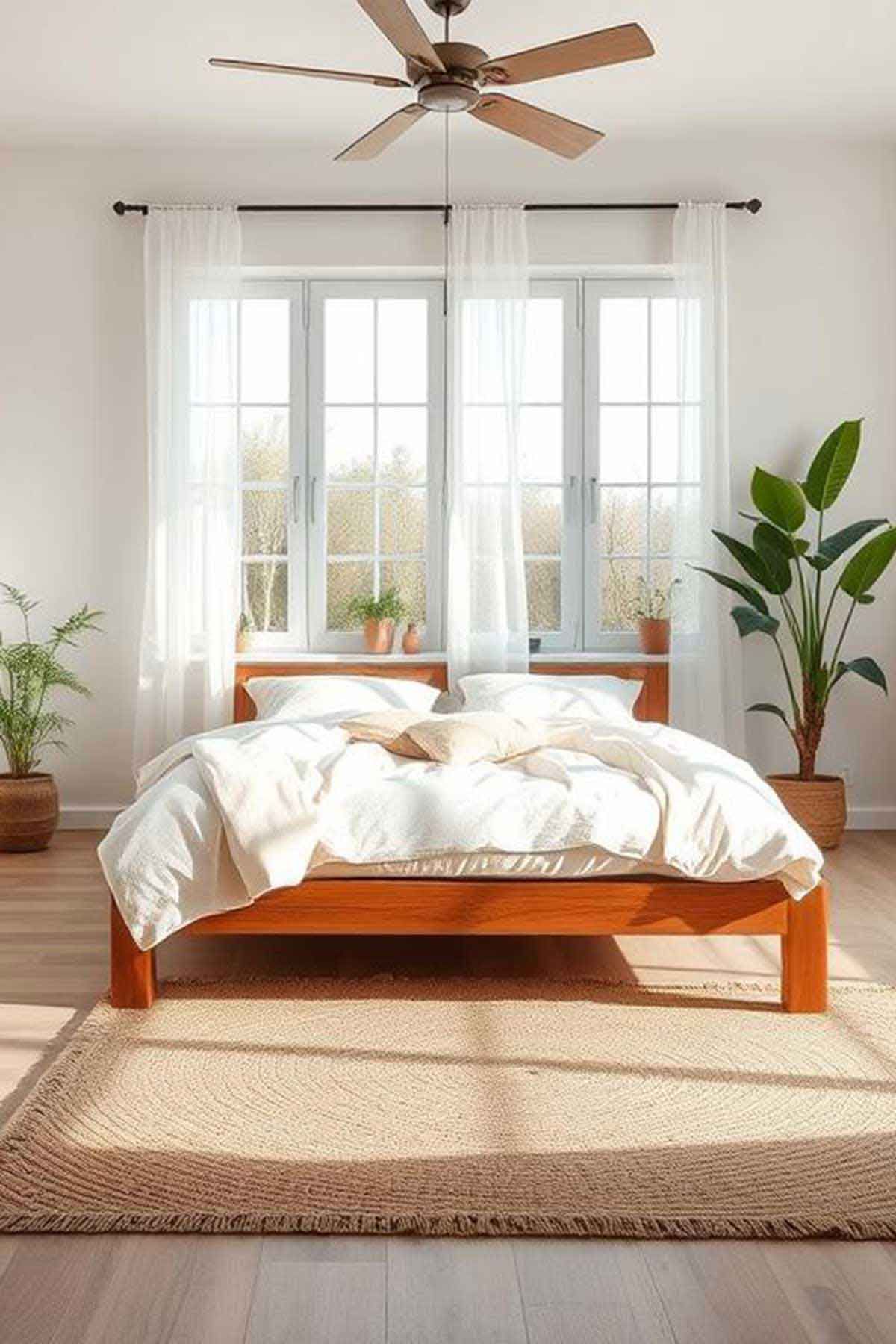
Integrating Natural Elements
Adding natural elements to your bedroom can make it a calm and restful place. Houseplants and natural light are great for improving sleep quality. They can make your bedroom a better place to relax and recharge.
Benefits of Houseplants for Air Quality
Houseplants are not just pretty; they also clean the air. They can lower stress by up to 20% and boost productivity by 15%. Plants remove harmful toxins and add oxygen, making your bedroom healthier and more refreshing.
- Peace lilies, snake plants, and pothos are effective air-purifying plants to consider for your bedroom.
- Placing plants around your bed can make your room feel more relaxing and help you sleep better.
Natural Light and Its Calming Effects
Natural light is key to a peaceful bedroom. It helps your body keep a regular sleep schedule, improving how well you sleep and your energy. Having lots of natural light in your bedroom can also make you happier and less stressed, making sleep even better.
By
designing your bedroom for sleep and adding these natural elements, you can make a peaceful sleep space. This space will help you rest better and feel better overall.
Soundproofing Your Sleep Area
Getting a good night's sleep is key to feeling your best. But, outside noises can easily ruin your rest. Traffic sounds, a neighbour's dog, or a partner's snoring can all disturb your sleep. Luckily, there are ways to make your sleep area quieter and more peaceful.
The Effects of Noise on Sleep Quality
Even a little noise can hurt your sleep. For some, noise is a big problem. It can mess up your sleep patterns, making it hard to fall asleep and stay asleep.
Tips for Reducing Noise Distractions
- Use earplugs or noise-cancelling headphones to block out external sounds.
- Consider investing in a white noise machine or playing soothing nature recordings to mask disruptive sounds. But, this might not work well if someone nearby snores.
- Install heavy curtains, blackout blinds, or acoustic panels to reduce noise penetration through windows and doors. Acoustic curtains can weigh up to 5 kilos, effectively blocking and deflecting sound.
- Seal any gaps or cracks around doors and windows to prevent sound from leaking into your sleep area. Door sweeps and draft excluders can be helpful in this regard.
- Soundproof your walls by adding mass, such as insulation or drywall, to prevent sound transmission. This can be a more extensive and costly solution, so it's advisable to consult an acoustic consultant for professional advice.
Dealing with noise might mean talking to family, housemates, or neighbours. Be understanding and try to find solutions everyone can agree on. If the problem doesn't go away, you might need to call local noise control authorities.
By using these soundproofing tips, you can make your sleep area quieter and more peaceful. A quiet, calm place to sleep can greatly improve your sleep and overall health.
Don't forget that sometimes learning to sleep with a little sound means you can sleep better in more places. I am an awful sleeper but over the years (and 2 sleep schools) have taught me that blocking out everything at home, means that when I go away and there are different noises it makes my sleep worse.
Now I try and sleep everywhere there is noise to train myself. Regardless I still need it pitch black though!
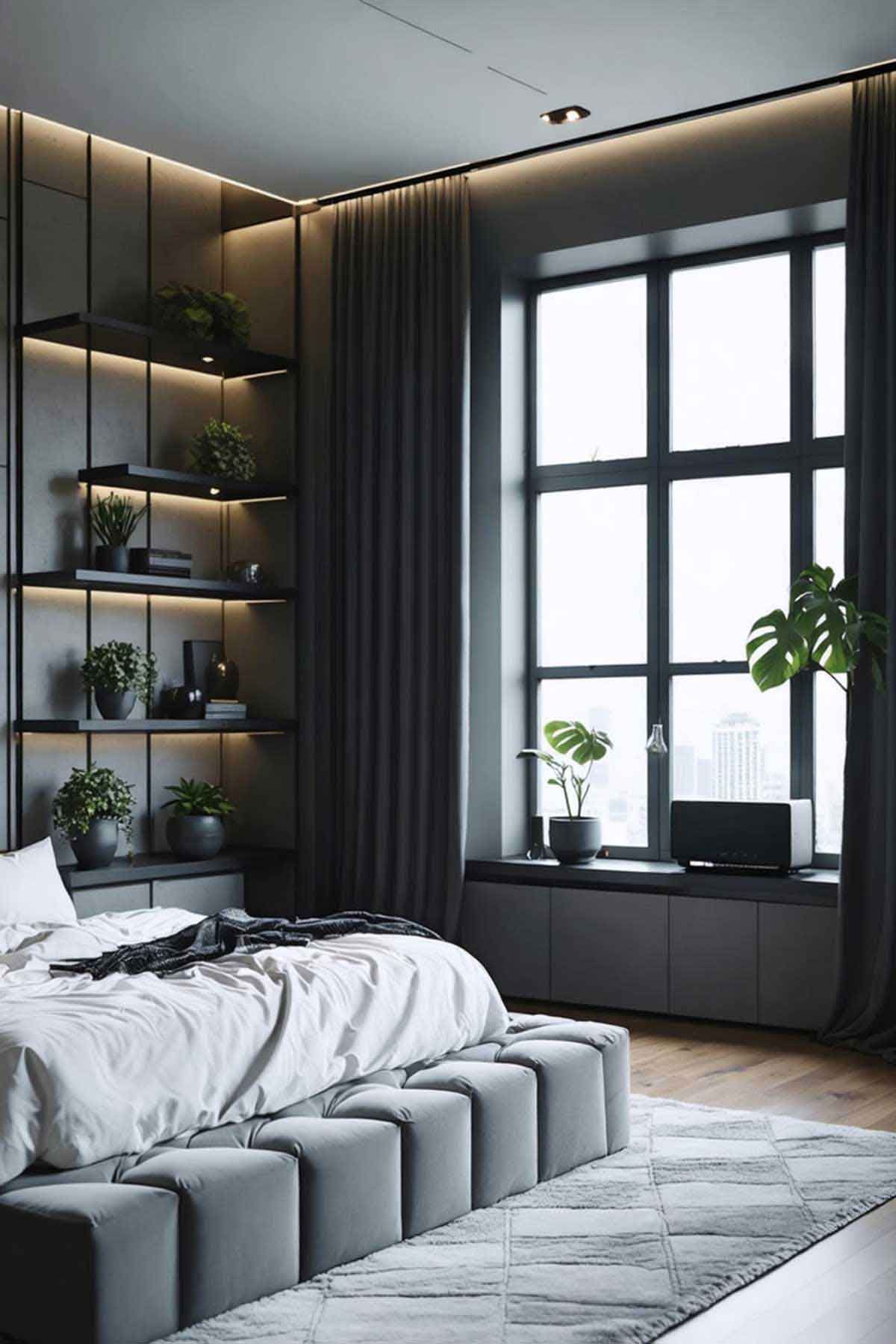
Temperature Control for Comfort
Keeping the right temperature in your bedroom is key for a good night's sleep. The best temperature for adults is between 18-20°C. This helps your body stay at a steady temperature all night. Typically you need to drop your temperature even a fraction to sleep. I sleep way better in cooler climates even though I get very cold and always have a doona on.
In summer we don't have air conditioning (well we do but rarely use it), but with just a fan I still pull up the doona overnight.
Ideal Bedroom Temperature for Sleep
Babies need a warmer room, up to 21°C. They are still learning to control their body temperature, but by 11 weeks, they can keep their body warm enough for sleep.
Methods to Regulate Room Temperature
- Use air conditioning or fans to keep the room cool.
- Close blinds or curtains during the day to keep it cool.
- Lower the thermostat at night to match your body's temperature.
- Get smart AC units that adjust based on the season and room use.
- Keep a regular sleep schedule and practice good sleep habits to help control your body temperature.
Creating a cozy, temperature-controlled sleep area is important. Try different ways to find what works best for you.
"Lowering the thermostat at night can work in tandem with natural temperature fluctuations to promote deeper, more restful sleep."
Personalizing Your Sleep Space
Making your bedroom a sleep sanctuary is key. Add meaningful items and cozy spots to turn it into a place of relaxation. Let's see how to make your sleep space truly yours.
Incorporating Personal Items for Comfort
Surround yourself with items that bring joy or hold special meaning. Photos, artwork, or crafts can make your space warm and cozy. Placing these items thoughtfully can make your space both beautiful and meaningful.
Soft textiles like a favourite quilt or throw add to the coziness. These elements help make your bedroom a reflection of your style and preferences.
Creating a Cozy Reading Nook
Set up a cozy reading area in your bedroom. Use a comfy chair, a side table, and soft lights to create a relaxing spot. This nook can be your own little retreat, perfect for unwinding before bed.
Adding natural elements like plants or a small water feature can make your reading area even more calming. The greenery and sound of water can help you sleep better.
"A well-designed bedroom should be a personal oasis that reflects your unique style and preferences, promoting a sense of comfort and relaxation for optimal sleep."
By adding personal touches and cozy spots, you can make your bedroom a sleep haven. It's a chance to create a space that meets your needs and preferences.
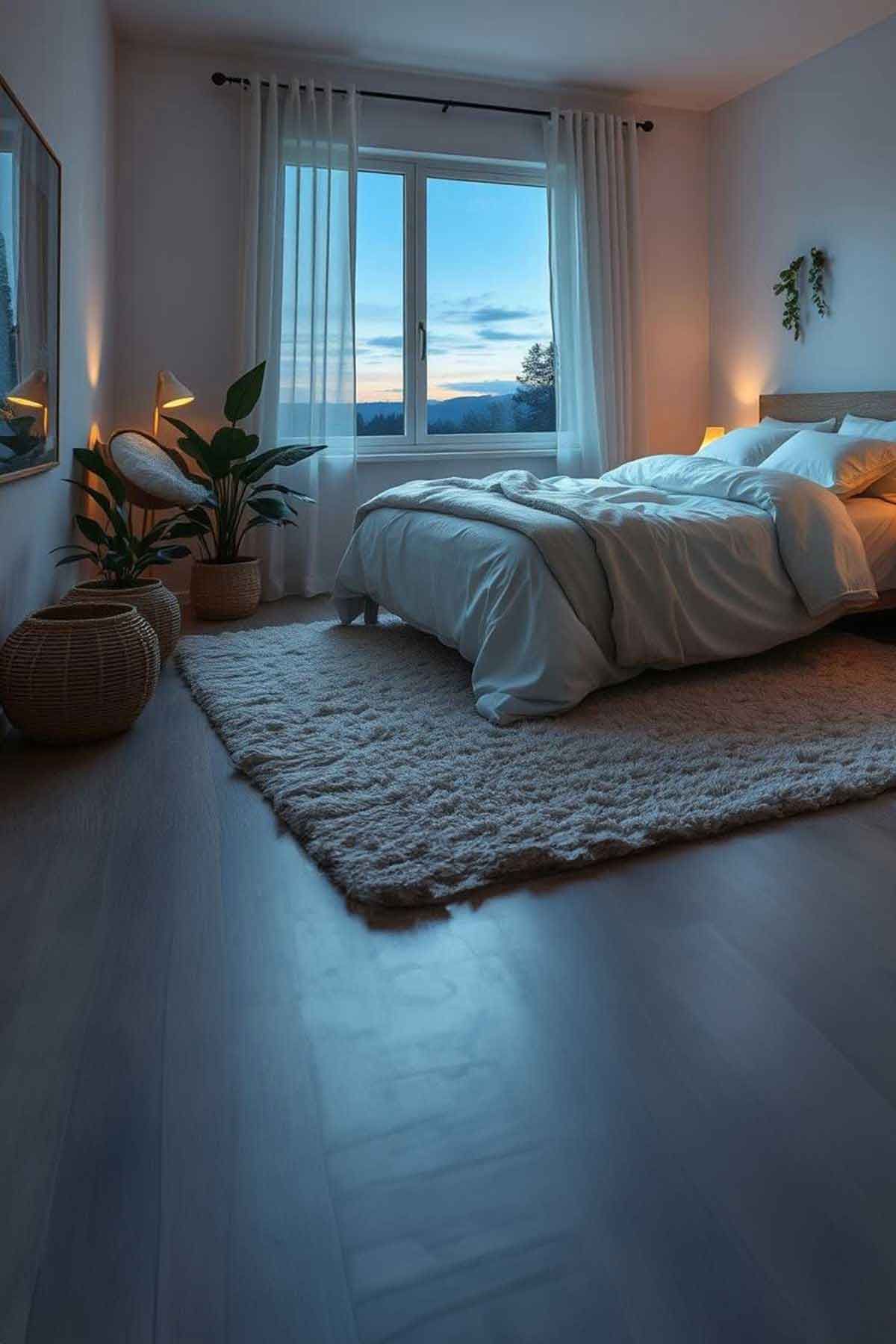
Maintaining a Clean Sleep Environment
Creating a restful sleep environment is more than just the right bedding and décor. It's also about keeping your space clean and clutter-free. A tidy, hygienic bedroom can greatly improve your sleep quality and overall well-being.
The Importance of Regular Cleaning
Regular cleaning is key to a dust-free, allergen-free bedroom. Make your bed every day, but let it "breathe" to avoid dust mites. Wash your bedding weekly, including sheets, pillowcases, and blankets.
Vacuum the floor and wipe down surfaces to remove dirt or debris. This keeps your bedroom healthy for sleep.
Tips for Decluttering Your Sleep Area
Clutter in your bedroom can make you stressed and feel less well. Use smart storage solutions to keep your sleep area organized. Choose stylish drawers, shelves, or storage ottomans to hide items that don't belong.
By keeping your bedroom tidy, you create a calming space. This promotes better sleep and relaxation. If you love the minimalist feel maybe investigate the role of negative space in modern interiors a little more
FAQ
How can transforming my bedroom into a peaceful sanctuary improve my sleep quality?
Making your bedroom a peaceful place can really help your sleep. Experts say a good sleep space is key for health. You should get a quality bed, pick calm colours, and add soft things to keep it tidy and cozy.
Why is a proper sleep environment crucial for overall health and well-being?
A good sleep space is vital for your health. Stress and outside factors can hurt your sleep. A calm bedroom helps lower stress and improves sleep. It should be a place for rest, not work or daily tasks.
How does colour choice affect the tranquillity of my sleep space?
Choosing colours is important for a peaceful sleep area. Soft, muted, or cool colours are best for walls, curtains, and bedding. Earthy tones can make it feel warm and grounding. Colours can help relax you and get your body ready for sleep.
What should I consider when choosing bedding for better sleep quality?
The right bedding is key for good sleep. Choose breathable, natural materials like cotton or bamboo. A thread count of 200 to 400 feels luxurious. Using lavender-scented detergent can also help relax you. Mixing different textures adds style and comfort.
How can I find the perfect mattress for my sleep needs?
Finding a supportive mattress is essential for sleep. Think about what you like and your sleep position when picking firmness. Look at mattresses made from natural materials for comfort and support.
How does room layout impact my sleep quality?
The layout of your room affects your sleep. Place your bed against a solid wall for easy access. Keep the room clean and avoid clutter. An open, airy space helps you relax and sleep better.
How can I integrate natural elements to enhance my sleep quality?
Adding natural elements can improve your sleep. Plants clean the air and calm you. Natural light helps your mood and energy. Art with serene landscapes can also help you relax.
How can I create a quieter sleep environment?
Noise can disrupt your sleep. Use earplugs or a white noise machine to block out sounds. Heavy curtains or shades can also help. Soundproofing your walls and windows can make it quieter.
What is the ideal temperature for my bedroom?
The right temperature is important for sleep. Keep your bedroom between 60 to 67 degrees Fahrenheit. Open windows or use an air purifier for ventilation. Breathable bedding helps keep you cool at night.
How can I personalize my bedroom to create a more comforting environment?
Make your bedroom your own for comfort. Add things that relax and make you happy, like photos or art. Create a cozy reading spot with a chair and soft light. Lavender scents can also help you relax.
Why is a clean bedroom important for better sleep?
A clean bedroom helps you sleep better. Make your bed daily but let it air out to avoid dust mites. Wash bedding and vacuum often. A tidy room reduces stress and improves sleep.
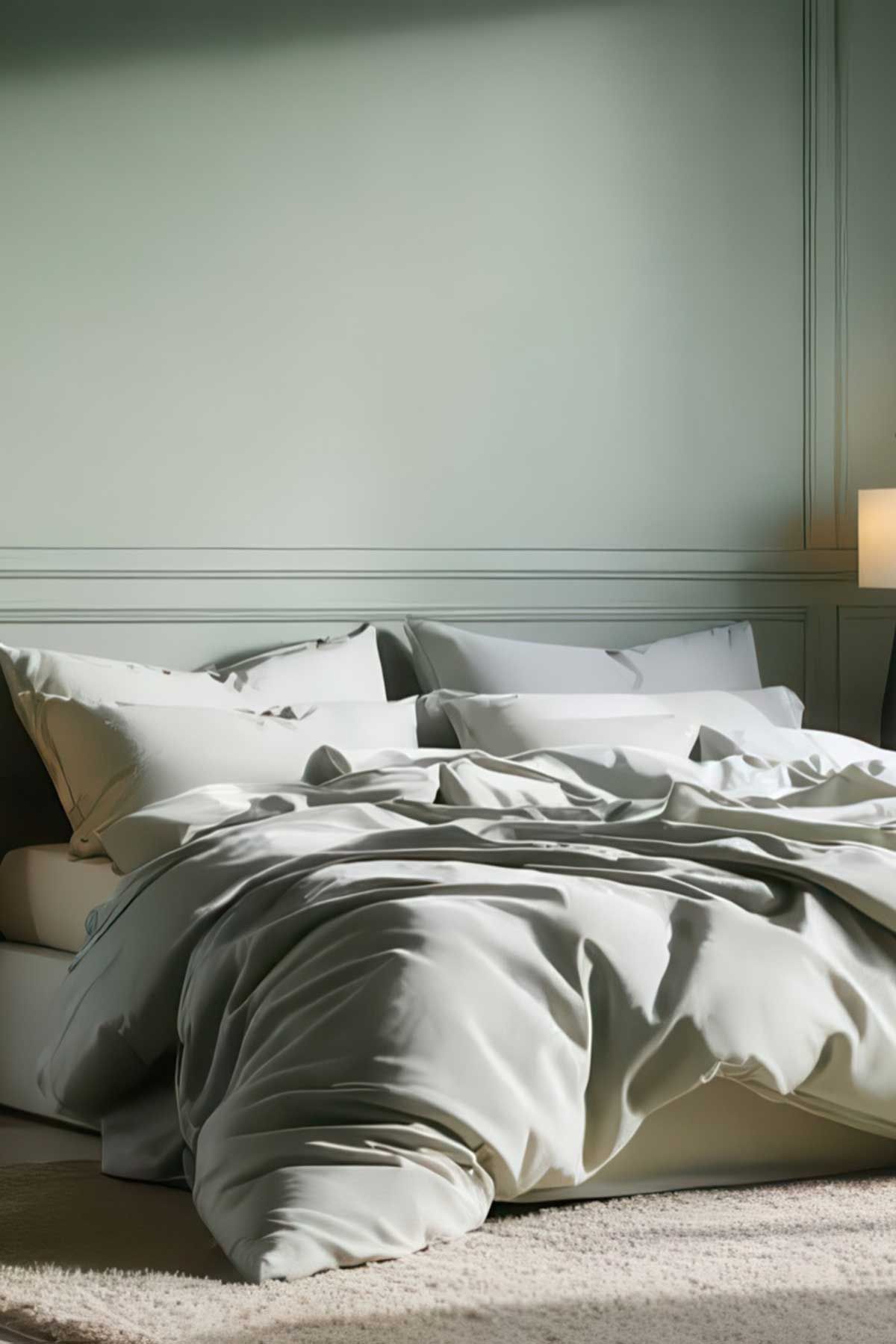
More BEDROOM Posts
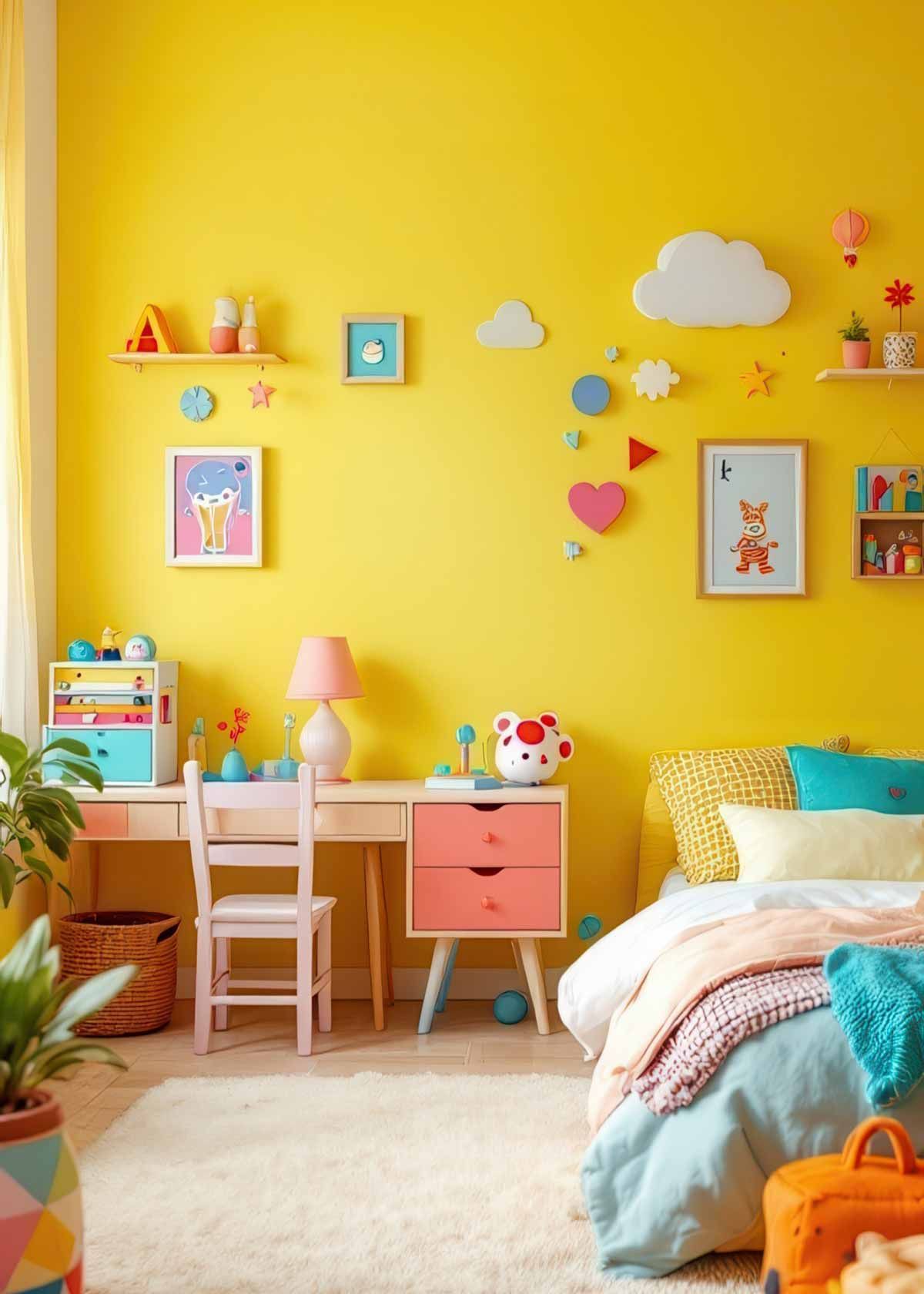

About The Author
I'm Channing and I am the driving force behind Platypus and Pine. I've had over 30 years of experience in designing, renovating and customising Australian homes.
I've used everything from aluminium to velvet as decor choices and love a wide variety of styles and themes.
My absolute favourite is Mid Century Modern and I was fortunate enough to spend 2 weeks in Palm Springs for Modernism week just last year.

